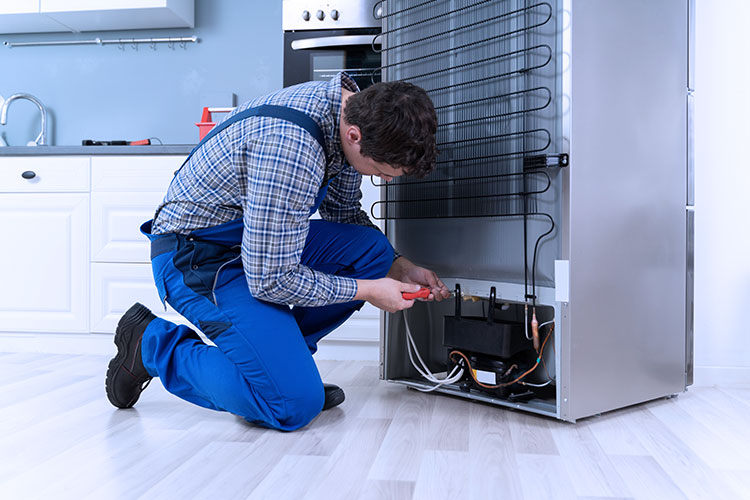The Ultimate Guide to Do It Yourself Home Appliance Repair Strategies
From refrigerators to dish washers, recognizing how to troubleshoot and fix these devices can save you time and money. Are you prepared to find crucial strategies that will empower you to handle repair work confidently?
Comprehending Typical Home Appliance Issues
When you depend on your home appliances, it can be annoying when they all of a sudden stop functioning or act up. Recognizing typical home appliance issues can help you troubleshoot concerns properly.
If your stove isn't home heating, malfunctioning elements or thermostat issues can be at fault. Dishwashers often experience problems with water drainage, so make certain the filter is clean and the drain tube isn't kinked.
Likewise, listen for unusual sounds; they often show mechanical concerns. By acknowledging these signs, you can conserve time and possibly avoid costly fixings. A little understanding goes a long means in preserving your appliances, so remain notified to maintain every little thing running smoothly.
Vital Devices for DIY Services
Before diving right into DIY device repair work, it is very important to gather the right devices to guarantee the process goes efficiently. Start with an excellent set of screwdrivers, including both flathead and Phillips, as they're crucial for opening most home appliances. You'll additionally desire a pair of pliers for grasping and turning cables or little parts.
Don't fail to remember a multimeter; it aids you test electric parts and identify concerns effectively. A socket collection comes in handy for loosening or tightening up bolts, while an energy blade can be helpful for reducing wires or opening product packaging.
Ultimately, consider having a flashlight handy to brighten dark spaces inside your home appliances. With these important tools, you'll be well-appointed to tackle various repair services, conserving both money and time. Collect your equipment and get ready to roll up your sleeves!
Security First: Precautions to Take
Before you start any type of device repair, it's necessary to focus on safety. Make sure you wear personal safety tools, disconnect the power source, and maintain your workplace organized. These easy safety measures can assist avoid mishaps and guarantee a smoother repair process.

Individual Safety Equipment
Security equipment is an essential component of any kind of Do it yourself home appliance repair service job. Steel-toed boots are also a smart selection, specifically when lifting heavy appliances. Remember, being prepared with the appropriate gear keeps you secure and concentrated on completing your repair efficiently.
Power Resource Disconnection
To guarantee a secure DIY appliance repair, separating the source of power is necessary. Before you start any kind of work, you should disconnect the home appliance or transform off the breaker. This basic step protects against electrical shocks and guarantees that you can concentrate on the repair work without bothering with unexpected activation. Always double-check that the device is off by evaluating it with a voltage tester. If you're managing larger home appliances, like a washer or dryer, make certain to secure the power cable and avoid any type of call with water. Keep in mind, security! Once you're confident that the power is disconnected, you can confidently proceed with your repair work, recognizing you have actually taken the essential preventative measures to protect on your own.
Workplace Organization
A well-organized work area can make all the difference in your DIY appliance repair work job. Begin by clearing your office of mess to stop disturbances and crashes. Outline all your devices and products, grouping similar items together for simple gain access to. Utilize a toolbox or organizer to keep tiny components like washing machines and screws consisted of and classified. See to it you've got appropriate lights; it'll help you see details clearly and lower the threat of mistakes. Do not neglect to maintain safety and security equipment like gloves and goggles available. Ultimately, have a garbage bag helpful to deal with waste promptly. A clean area not only enhances effectiveness but additionally maintains you safe while you function on your home appliance repair work.
Step-by-Step Overview for Refrigerator Fixes
When your fridge begins acting up, it can be frustrating, yet taking on the issue on your own can save you money and time. Disconnect the refrigerator to guarantee security. Check for typical concerns like temperature variations or uncommon sounds. If it's not cooling, check the thermostat setups; they may be set too expensive. Next off, tidy the condenser coils, which usually gather dirt and particles. For a noisy refrigerator, check the fan and confirm link it's not obstructed.
If there's water merging inside, inspect the door seals for damages or dust, and clean them if needed. When you've dealt with the issue, connect the fridge back in and monitor it for a couple of hours.
Taking Care Of Cleaning Device Issues
Just like fridges, washing equipments can provide their own set of obstacles, however many concerns can be settled with a bit of troubleshooting. If your equipment will not begin, examine the power cable and validate it's connected in.
If your clothes aren't getting tidy, take into consideration the water degree and detergent type; utilizing way too much detergent can produce excess suds, impacting performance. For leaks, analyze the hose pipes for fractures or loose connections. Tightening these can often solve the problem. Regular maintenance, like cleaning the filter, can avoid lots of issues from arising. Keep in mind, a little troubleshooting goes a long means in maintaining your washing machine running smoothly.
Troubleshooting Ovens and Ranges
Exactly how can you fix common concerns with your stove or range? Start by examining the power supply. Make sure it's plugged in and the breaker is not tripped. If it's a gas stove, validate the gas shutoff is open. Next, examination the burners: if they do not spark, clean the igniter and look for blockages in the heater ports.
If your oven isn't home heating, examine the temperature setups and verify the door seals tightly. If it's harmed., a defective home heating aspect could likewise be the culprit; you may need to change it.
For uneven cooking, revolve your pans and take into consideration utilizing a stove thermometer to confirm accurate temperature levels. If you hear unusual sounds or scent gas, turn off the home appliance quickly and consult an expert. By adhering to these actions, you can identify and solve several common oven and stove concerns effectively.
Fixing Dishwashing Machines Facilitated
When your dish washer begins breaking down, it can be frustrating, yet dealing with common issues isn't as hard as it seems. You'll discover step-by-step troubleshooting techniques that will certainly assist you determine the issue, along with the necessary devices you'll need to take on repairs yourself. Let's make fixing your dish washer a wind!
Common Dishwashing Machine Concerns
While dishwashing machines are developed to make your life much easier, they can often encounter typical problems that leave you feeling annoyed. One regular problem is poor cleansing efficiency; this usually takes place as a result of stopped up spray arms or filthy filters. You might also see water merging near the bottom, which can suggest a kinked tube or a damaged drainpipe. If your dishwashing machine's door won't lock, maybe a basic problem with the latch device or door seal. In addition, odd noises can signify worn-out components or loosened components. Lastly, if you smell something odd, it may be time to look for food particles or a from this source malfunctioning motor. Attending to these concerns early can save you time and trouble down the road (Best Sub-Zero Service Near You Dependable Refrigeration & Appliance Repair Service).

Step-by-Step Troubleshooting
Before diving right into repairs, it's important to identify the certain problem your dish washer is facing. Beginning by checking if it's not cleaning correctly. Evaluate the spray arms for clogs and warranty they spin easily. If it's dripping, analyze door seals and pipes for any damage. For unusual sounds, pay attention closely throughout cycles; international objects may be embeded the filter or impeller. If your dish washer won't start, inspect the power supply and door lock. Do not forget to consult your user manual for repairing pointers particular to your model. By methodically attending to each potential concern, you can pinpoint the trouble and take the required steps to repair it, making your dishwasher function like new once again.
Essential Repair Tools
Having the right devices at your disposal can make all the difference see here now when repairing your dish washer. Do not forget a pail or towels for any kind of water spills throughout repair work.
You might additionally want a degree to guarantee your dishwashing machine's effectively lined up. With these crucial tools, you'll be fully equipped to take on any dish washer repair difficulty that comes your means.
Frequently Asked Concerns
If an Appliance Is Well Worth Fixing?, how Do I Identify.
To figure out if a device's worth repairing, consider its age, repair work expenses, and existing worth. You could desire to invest in a new design rather - Dependable Appliance For SubZero Freezer Repair. if repairs exceed half the replacement cost.
Can I Discover Replacement Parts Locally for My Home Appliance?
Yes, you can commonly locate substitute components in your area for your device. Examine equipment stores, home appliance repair service shops, or local classifieds. Don't forget to bring the model number to guarantee you obtain the proper component!
What Typical Mistakes Should I Stay Clear Of When Repairing Home Appliances?
When fixing home appliances, prevent rushing through diagnostics, overlooking safety and security preventative measures, or using incorrect tools. Don't miss checking out manuals or seeing tutorials; they give necessary assistance. Be client and comprehensive to guarantee effective repair work and prevent more damages.
For how long Does a Normal DIY Appliance Repair Service Take?
A common do it yourself home appliance repair work usually takes one to 3 hours, depending upon the complexity. You'll wish to gather your devices and materials initially, and comply with instructions very carefully to avoid unneeded delays.
Exist Any Type Of Guarantees for DIY Appliance Repairs?
When you deal with DIY home appliance fixings, guarantees typically don't cover your job. Some suppliers might honor service warranties for parts you change. Constantly check your home appliance's service warranty terms prior to starting any repair services to stay clear of issues.
Before diving into DIY home appliance fixings, it's important to gather the right tools to ensure the procedure goes efficiently.Prior to you begin any kind of appliance repair, it's vital to focus on safety and security.To guarantee a safe DIY home appliance repair service, separating the power resource is essential.A well-organized work area can make all the distinction in your Do it yourself device repair work task. Always check your home appliance's service warranty terms prior to starting any repair work to prevent concerns.